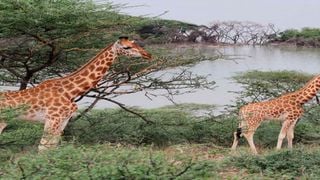
Rothschild giraffes at Lake Baringo Game Reserve.
| PoolNews
Premium
Worry as study shows Kenya’s Maasai giraffes on verge of extinction
What you need to know:
- Today, Africa is the only home for giraffes in the wild, where the modern giraffe evolved.
- Kenya is the giraffe stronghold. Of the nine subspecies of giraffes, three are found in the country.
The giraffe is one of the most featured wild animals in ancient rock art. Our hunter-gatherer ancestors living in caves were the early artists who portrayed their world on rocks. In faraway India, a giraffe appears in a cave painting from 12,000 years ago.
In Africa, the most fascinating one is a life-size engraving dated between 6,000 and 8,000 years ago of a male and female giraffe, dubbed the Dabous Giraffes, in the Air Mountains of central Niger.
The pair is the world’s largest known animal petroglyphs, first recorded in 1987 and documented in 1997 by David Coulson, a Kenyan photographer and founder of the Trust for African Rock Art (TARA). In an earlier interview, Coulson said of the 20-foot giraffe etchings: “You can only see them in their entirety from the air”.
Giraffe ancestry is steeped in antiquity, first appearing 25–20 million years ago, with different species spreading across Eurasia and Africa. The modern giraffe in the genus Giraffa, only entered Africa around seven million years ago, strolling in from China and northern India.
Today, Africa is the only home for giraffes in the wild, where the modern giraffe evolved one million years ago in eastern Africa.
Today, Kenya in eastern Africa is the giraffe stronghold. Of the nine subspecies of giraffes, three are found in Kenya – the Rothschild, the Reticulated and the Maasai.
As with my generation of the 1960s, giraffes were prolific on the Kenyan landscape, tall necks sticking out on the plains and laughable if anyone suggested that they would be in short supply in years to come.
Now the Rothschild is listed as critically endangered on the IUCN Red List, one step short of becoming extinct in the wild. The Reticulated and the Maasai have stepped up from vulnerable to endangered.
The situation of these towering animals is dire.
Giraffe populations
“We see a 40 percent decline in giraffe populations across Africa between 1985 and 2005,” said John Kabue Njueini, a recent graduate of the University of Nairobi who researches giraffe conservation, during a presentation at Nature Kenya, also known as the East African Natural History Society, founded in 1909.
“In many countries like Mali they are extinct.”
In neighbouring Niger, home of the life-size petroglyphs, a few hundred compete for space with humans.
Focusing his research on the Maasai giraffe in the 43,000-square-kilometre Tsavo enclave that is a mix of Tsavo national parks, private ranches, wildlife conservancies and farms in south-eastern Kenya, he fears that these gentle giants may be slowly sliding into extinction.
Human encroachment and poaching are the main causes for that. Yet, ironically, when the 22,812-square-kilometre Tsavo National Park was established in 1948, it was primarily cast away as land useless for agriculture.
At the time, Tsavo was famous for its large herds of elephants and lions, rhinos and raptors. Giraffes were common. Even today, Tsavo boasts the largest population of the Maasai giraffe.
However, the situation is dire. The land around the protected parks (divided into East and West for ease of management) is rapidly being cleared away for subsistence farming, blocking the migratory routes of the wildlife. In tandem, modern-day infrastructure like the standard gauge railway, the fast motorway, power lines, high fences, farms and burgeoning roadside towns add to the dilemma.
“We see the range for giraffes has reduced by 4.7 percent between 2016 and 2018,” states the giraffe researcher. Fifty-nine percent of these gentle giants are now found in protected areas like the national parks. In earlier years the opposite was true,” Njueini said.
“Another shocking finding is the very organised cartel of poachers who target giraffes, and more specifically the males, who weigh more than females. It’s a cheap source of protein.”
Bush-meat trade
An adult male weighs two tonnes. A tonne of meat sold across the border in Tanzania fetches Sh100,000. Less is sold in Kenya, where hunting is not allowed, unlike in Tanzania where it is allowed under licence since 2015 for game meat and trophies.
It creates a loophole for poachers to trade in Tanzania through porous borders. In Kenya, hunting is illegal but the bush-meat trade is rife because of poor law enforcement and lenient punishment – a paltry Sh20,000 fine or six months’ imprisonment.
Njueini’s research reveals some 500 are poached every year.
With a population of 4,000 Maasai giraffe in Tsavo, they may be slowly sliding into extinction.
“There is a need for trans-boundary collaboration between Kenya and Tanzania,” continues Njueini.
He also lists a whole gamut of recommendations: better laws and law enforcement, increased community engagement and eco-tourism, better land management that ensures wildlife dispersal areas and infrastructure planning.
If the world’s tallest animal vanishes in the wild in Africa, it will reflect on us as failures.




